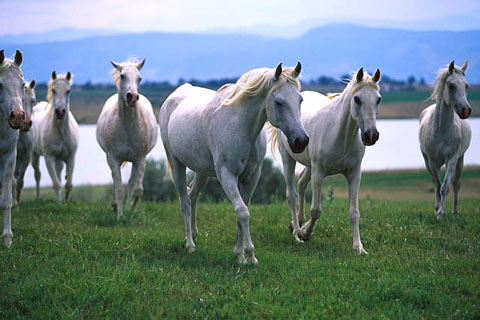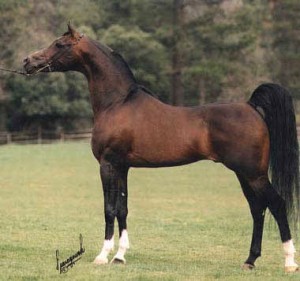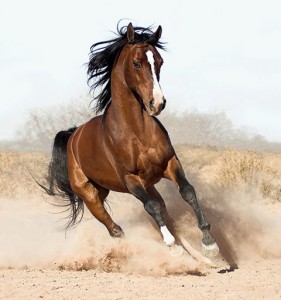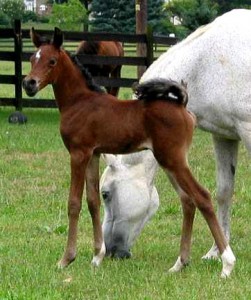
One of the most popular breeds of horses found in America is the Arabian. With a distinctive head shape and high tail carriage, the Arabian is one of the most easily recognizable horse breeds in the world.
From the Arabian Horse Organization website:
“From the ancient deserts of the Middle East evolved the oldest known breed of riding horse, the Arabian. Now one of the most popular breeds in America, the Arabians’ incredible energy, intelligence and gentle disposition allow riders to excel in most equine sports and activities. Today, Arabian horses spend as much time on the trail as they do at horse shows and other competitive events.
“For thousands of years, Arabians lived among the desert tribes of the Arabian peninsula, bred by the Bedouins as war mounts for long treks and quick forays into enemy camps. In these harsh desert conditions evolved the Arabian with its large lung capacity and incredible endurance.
“Historical figures like Genghis Khan, Napoleon, Alexander The Great and George Washington rode Arabians. Even today, one finds descendants from the earliest Arabian horses of antiquity. Then, a man’s wealth was measured in his holdings of these fine animals. Given that the Arabian was the original source of quality and speed, and remains foremost in the fields of endurance and soundness, he still either directly or indirectly contributed to the formation of virtually all the modern breeds of horses.
 “The prophet Mohammed, in the seventh century AD, was instrumental in spreading the Arabian’s influence around the world. He instructed his followers to look after Arabians and treat them with kindness. He instructed that special attentions should be paid to the mares because they insure the continuity of the breed. He also proclaimed that Allah had created the Arabian, and that those who treated the horse well would be rewarded in the afterlife.
“The prophet Mohammed, in the seventh century AD, was instrumental in spreading the Arabian’s influence around the world. He instructed his followers to look after Arabians and treat them with kindness. He instructed that special attentions should be paid to the mares because they insure the continuity of the breed. He also proclaimed that Allah had created the Arabian, and that those who treated the horse well would be rewarded in the afterlife.
“The severe climate required the nomads to share food and water, and sometimes even their tents with their horses. As a result, Arabians developed a close affinity to man and a high intelligence.
“Over the centuries, the Bedouin tribes zealously maintained the purity of the breed. Because of their limited resources, breeding practices were extremely selective. Such practices, which eventually helped the Arabian become a prized possession throughout the world, have led to the beautiful athletic breed we know today, which is marked by a distinctive dished profile; large, lustrous, wide-set eyes on a broad forehead; small, curved ears; and large, efficient nostrils.
“Even today the purebred Arabian is virtually the same as that ridden in ancient Arabia. Arabians now display their athletic talents in a variety of disciplines from English to Western, with the Arabian positioned as the undisputed champion of endurance events.
“America was built by utilizing horse power and colonists were quick to realize the value of Arabian bloodstock. Nathan Harrison of Virginia imported the first Arabian stallion in 1725. This horse reportedly sired 300 foals from grade mares. Our first President, George Washington, rode an Arabian horse. The first breeder of consequence, however, was A. Keene Richard. He journeyed into the desert in 1853 and 1856, subsequently importing several stallions and two mares. However, his breeding program fell victim to the Civil War and nothing survived.
 “In 1877, General Ulysses S. Grant visited Abdul Hamid II, His Imperial Majesty the Sultan of Turkey. There, he was presented with two stallions from the Sultan’s stable, Leopard and Lindentree. Leopard was later given to Randolph Huntington who subsequently imported two mares and two stallions in 1888 from England. This program, limited as it was, must be considered as the first purebred Arabian breeding program in the United States.
“In 1877, General Ulysses S. Grant visited Abdul Hamid II, His Imperial Majesty the Sultan of Turkey. There, he was presented with two stallions from the Sultan’s stable, Leopard and Lindentree. Leopard was later given to Randolph Huntington who subsequently imported two mares and two stallions in 1888 from England. This program, limited as it was, must be considered as the first purebred Arabian breeding program in the United States.
“The Chicago Worlds Fair held in 1893 drew widespread public attention and had an important influence upon the Arabian horse in America. World’s FairWhile every country in the world was invited to participate, Turkey chose to exhibit 45 Arabian horses in a “wild eastern” exhibition. Among the imported Arabians shown were the mare Nejdme and the stallion, Obeyran. Both subsequently became foundation animals No. 1 and No. 2 in the Arabian Stud Book of America (later changed to the Arabian Horse Registry of America and now, Arabian Horse Association). Several years later, two other mares and one stallion were also registered. Many breeding farms today have horses whose pedigrees trace to these 19th century Arabians.
“Historical importations from England and Egypt were made soon after the Fair by such breeders as Spencer Borden, who imported 20 horses between 1898 and 1911 to his Interlachen Stud, and W.R. Brown who imported 20 horses from England, 6 from France and 7 from Egypt between 1918 and 1932.
“One of the most significant importations occurred in 1906, when Homer Davenport received permission from the Sultan of Turkey to export Arabian horses. Davenport, with the backing of then President Theodore Roosevelt, imported 27 horses which became the foundation of “Davenport Arabians.” The Davenport importation of Arabian horses direct from the desert excited the few Arabian breeders in this country. This group of breeders decided that the time was right to form a registry to promote the horse and encourage the importation of new blood. In 1908, the Arabian Horse Club of America was formed (today known as the Arabian Horse Association) and the first stud book published. Recognition of the Arabian stud book by the U.S. Department of Agriculture established the Registry as a national registry and the only one for the purebred Arabian breed. Seventy-one purebred Arabians were registered at that point.
 “Another significant importation occurred in the 1920s, when the Kellogg Ranch, founded by W.K. Kellogg, brought in 17 select horses from the Crabbet stud farm in 1926 and 1927. Soon after, Roger Selby established the Selby Stud with 20 horses imported from Crabbet between 1928 and 1933. The Albert Harris importation consisted of two horses from England in 1924 and five from the Hejaz and Nejd desert regions in 1930 and 1931. Joseph Draper brought Spanish Arabians into the American picture when he imported five horses from Spain in 1934. J.M. Dickinson’s Traveler’s Rest Arabian Stud was established between 1934-1937 on an imported mare from Egypt and one from Brazil as well as seven mares from Poland. Henry B. Babson sent people to Egypt in 1932 who brought over two stallions and five mares. This farm still preserves the same bloodlines today.
“Another significant importation occurred in the 1920s, when the Kellogg Ranch, founded by W.K. Kellogg, brought in 17 select horses from the Crabbet stud farm in 1926 and 1927. Soon after, Roger Selby established the Selby Stud with 20 horses imported from Crabbet between 1928 and 1933. The Albert Harris importation consisted of two horses from England in 1924 and five from the Hejaz and Nejd desert regions in 1930 and 1931. Joseph Draper brought Spanish Arabians into the American picture when he imported five horses from Spain in 1934. J.M. Dickinson’s Traveler’s Rest Arabian Stud was established between 1934-1937 on an imported mare from Egypt and one from Brazil as well as seven mares from Poland. Henry B. Babson sent people to Egypt in 1932 who brought over two stallions and five mares. This farm still preserves the same bloodlines today.
“In the 1940’s and 1950’s importations of Arabians to America slowed down as American breeding programs evolved from the previously imported stock. With the death of Lady Wentworth in 1957 and the dispersal of Crabbet Stud, importations in abundance were again made from England, and the post-war stud farms of Germany, Poland, Russia, Spain and Egypt were “rediscovered.” Significant importations followed from these countries by several groups of dedicated breeders and again a new era of Arabian horse breeding dawned.”
You can get more information at the official Arabian breed horse organization at their website by clicking HERE.
If you have problems seeing the video below click HERE
.youtube::U7ShtgUXW1w::
